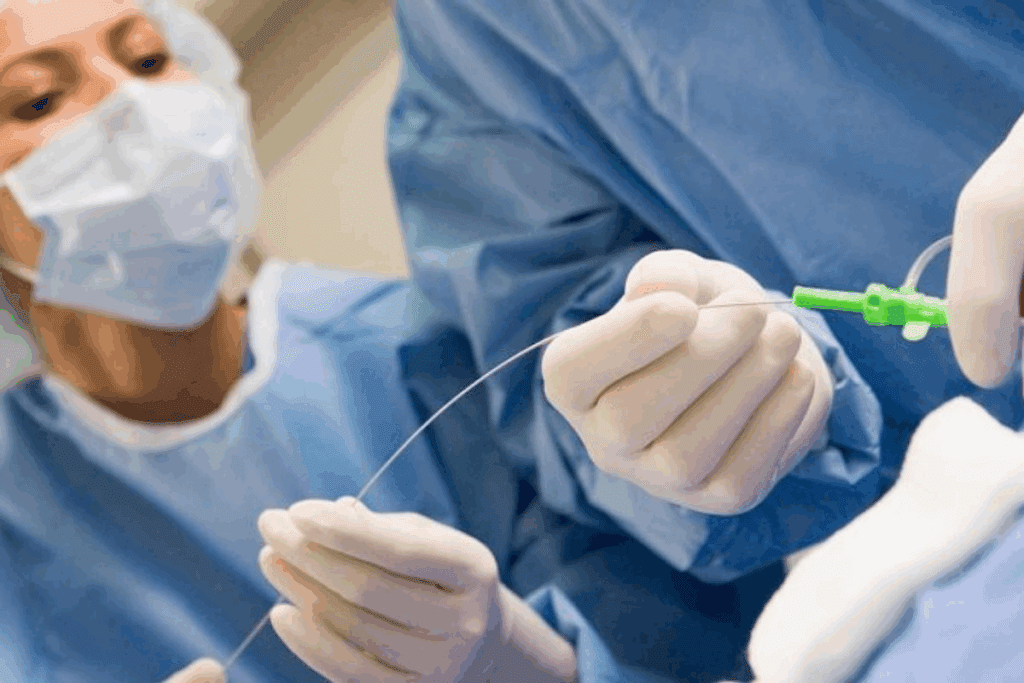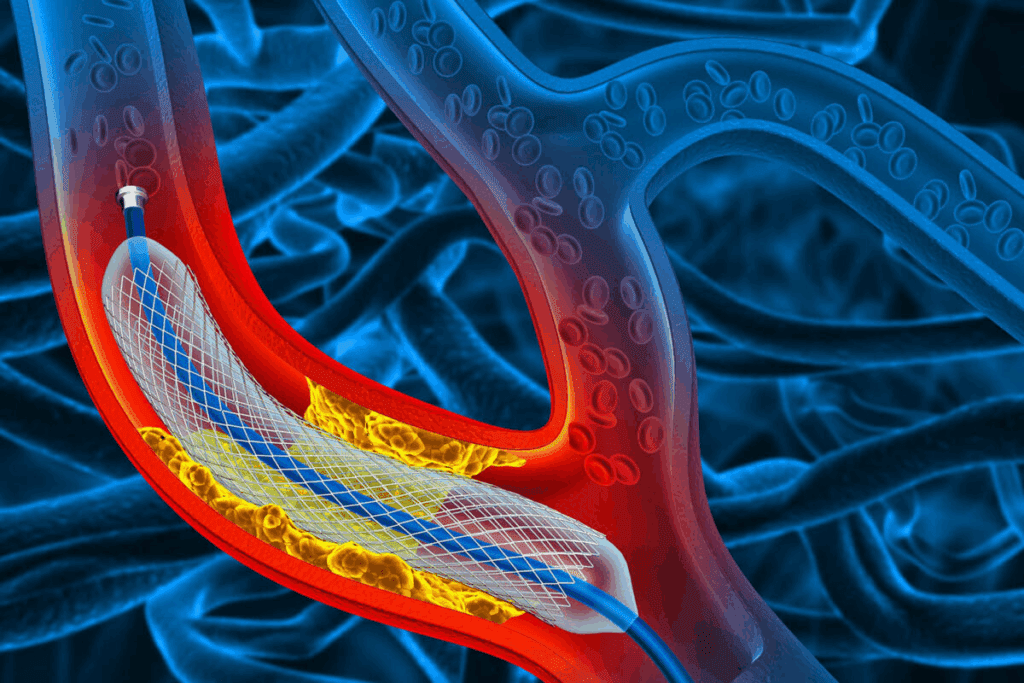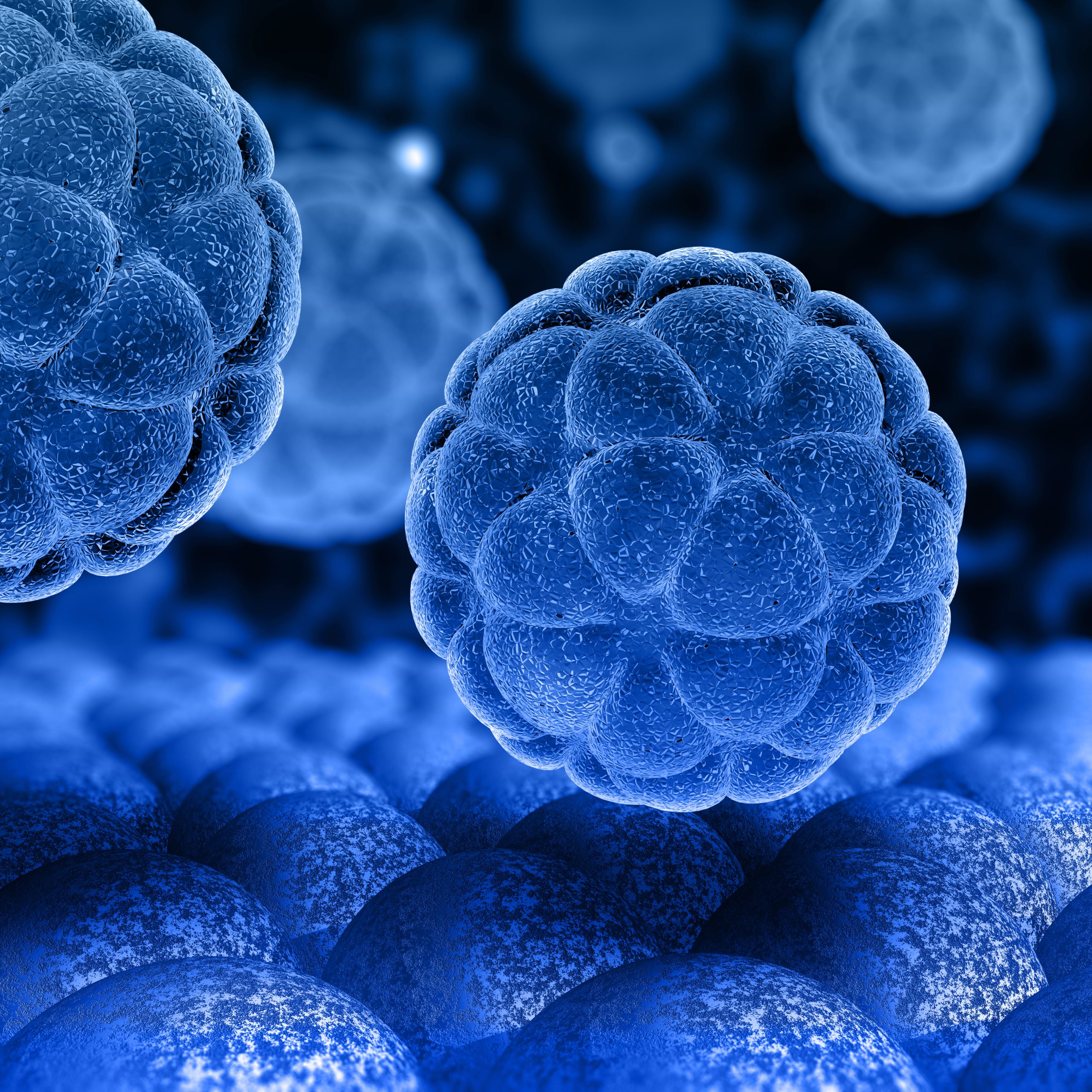Last Updated on November 26, 2025 by Bilal Hasdemir

At Liv Hospital, we know how vital clear information is for vascular health decisions. A stent is a small, mesh-like tube. It keeps narrowed or blocked vessels or ducts open, like arteries. This crucial medical device is made from metal or plastic and is inserted during a procedure called stenting.
Stents help people with blockages in their coronary arteries. They improve blood flow and treat many medical conditions. Our goal is to offer cutting-edge treatments and the best care possible.
It’s key for patients to understand the stent medical term and its role in medicine. We aim for international excellence in patient care. We use the latest academic protocols and offer both preventative and advanced treatments.
Key Takeaways
- A stent is a small, mesh-like tube used to keep arteries open.
- Stents are commonly used to treat blockages in coronary arteries.
- The stenting procedure involves inserting a stent to improve blood flow.
- Liv Hospital is committed to providing cutting-edge treatments and exceptional outcomes.
- Understanding the stent medical term is essential for patients making informed vascular health decisions.
Understanding the Stent Medical Term and Its Origins

The term “stent” has a rich history in medicine, starting in the late 19th century. To grasp the stent medical term, we must look at its origins and historical context.
Etymology and History of Stents in Medicine
The word “stent” comes from Charles Thomas Stent, a British dentist. He was known for his dental impression materials. Over time, the term grew to include more medical uses, mainly in heart medicine.
The first successful heart stent was placed on September 16, 1977, in Zurich, Switzerland. Andreas Grüntzig made this breakthrough in coronary angioplasty.
Stent technology has seen big improvements, leading to better patient care. Key milestones include bare-metal stents, drug-eluting stents, and bioresorbable stents. Each new type has made stent procedures safer and more effective.
Evolution of Stent Technology Over Time
Stent technology has grown a lot over the years. Some key advancements are:
- Introduction of drug-eluting stents, which release medicine to stop restenosis.
- Development of bioresorbable stents, which dissolve over time, aiming to reduce long-term issues.
- Improvements in stent materials and design, making them more flexible, easier to use, and stronger.
As stent technology keeps getting better, we can look forward to even more progress in patient care. The term “stent” is now a key part of medical language. It represents a support that has changed how we treat many health issues.
What Is a Stent? Basic Definition and Purpose

Stents are medical devices that help keep body structures open. They are mainly used for heart health issues.
A stent is a small, mesh-like tube. It’s made from metal or other materials. Its main job is to keep blood vessels or ducts open. This improves blood flow and helps with symptoms caused by narrow or blocked passages.
Core Function of Stents in the Human Body
Stents support and keep open narrowed or blocked vessels or ducts. They help restore normal blood flow. This reduces symptoms and prevents more problems.
For example, in coronary artery disease, stents keep the coronary arteries open. This ensures the heart muscle gets the oxygen and nutrients it needs. It greatly lowers the risk of heart attacks and other heart issues.
Common Materials Used in Stent Manufacturing
Stents are made from different materials, each with its own benefits. The most common include:
- Metal: Stainless steel and other alloys are used for their strength, durability, and body compatibility.
- Plastic or fabric: Some stents, like stent-grafts, are made from fabric or synthetic materials.
- Drug-eluting coatings: Many stents have coatings that slowly release medications. These prevent new tissue growth that could block the vessel again.
| Material | Characteristics | Common Applications |
| Stainless Steel | Strong, durable, biocompatible | Coronary stents, peripheral stents |
| Alloys (e.g., Nitinol) | Flexible, shape-memory properties | Peripheral stents, neurovascular stents |
| Drug-Eluting Coatings | Reduces restenosis | Coronary stents, other vascular stents |
Understanding stent materials and functions helps us see their importance in medicine. They greatly benefit patients who undergo stenting procedures.
The Difference Between Stent and Stint in Medical Terminology
“Stent” and “stint” are often mixed up, but they mean different things in medicine. Knowing the difference is key for clear talk in health care.
Clarifying Common Misconceptions
Many think “stent” and “stint” are the same. But they’re not. A stent is a medical tool to support or keep open a body part, like a blood vessel. A stint is about a short time doing something or a limited duty.
Here are some examples to show the difference:
- The doctor implanted a stent to keep the artery open.
- The nurse was assigned to a stint in the intensive care unit for three months.
In medical talk, “stent” is well-known. But “stint” is not used as much.
Proper Usage of Both Terms in Clinical Settings
In clinics, using these terms right is important to avoid mix-ups. When talking about the device, use stent. For example, “The patient had a coronary stent placed.”
But for talking about a duty or service time, use stint. Like, “The resident did a stint in the emergency department before moving to surgery.”
Here are some important points to remember:
- Use “stent” for the medical device.
- Use “stint” for a time or duty period.
Why the Term Stent Means Support Structure
The word stent comes from Charles Thomas Stent, a British dentist from the 19th century. He worked on dental materials, and his name is linked to devices that support or hold things in place.
Today, a stent is a small, mesh-like device to support or keep open a body part. The term now covers many medical devices, like coronary and peripheral stents.
The main thing to remember is that a stent is a support structure to keep a vessel or duct open. This helps improve patient care.
Types of Medical Stents and Their Applications
Stents are key in interventional medicine, each type for a specific use. They are small, mesh-like tubes that keep arteries open. This improves blood flow and lowers health risks.
Coronary Stents
Coronary stents treat coronary artery disease by keeping arteries open. They are vital in managing heart disease and preventing heart attacks. Drug-eluting stents release medication to prevent arteries from narrowing again.
Peripheral Vascular Stents
Peripheral vascular stents treat peripheral artery disease (PAD). They are placed in legs’ arteries to boost blood flow and ease symptoms like claudication.
Ureteral and Biliary Stents
Ureteral stents ensure urine flows from kidneys to bladder. Biliary stents keep bile ducts open, helping bile flow into the intestine. Both are key in managing blockages caused by stones or tumors.
Neurovascular Stents
Neurovascular stents treat neurovascular diseases like intracranial aneurysms and stenosis. They support the complex cerebral vasculature, preventing further issues.
Here’s a summary of the different types of stents and their applications:
| Type of Stent | Application | Key Features |
| Coronary Stents | Coronary Artery Disease | Drug-eluting, improves blood flow to the heart |
| Peripheral Vascular Stents | Peripheral Artery Disease | Improves blood flow to limbs |
| Ureteral Stents | Ureteral Obstructions | Ensures urine flow from kidneys to bladder |
| Biliary Stents | Bile Duct Obstructions | Facilitates bile flow into the intestine |
| Neurovascular Stents | Neurovascular Diseases | Supports cerebral vasculature |
Stent diversity and application target various medical conditions, improving patient outcomes. As technology evolves, we’ll see more stent innovations.
The Stent Medical Term in Clinical Practice
Using the right stent term in medical settings is key for patient education and keeping medical records. It’s important to use exact terms in healthcare.
Medical Coding and Documentation
Correct medical coding and documentation are vital for patient care and insurance. Proper coding makes sure patient records are clear and dependable. This helps in coordinating care well. We follow international coding standards for consistent medical records.
Stent Terminology in Patient Education
It’s important to explain stent procedures and care clearly to patients. We aim to teach patients using simple, non-technical language. This helps patients understand and follow their treatment plans better.
International Standardization of Stent Terminology
Healthcare is global, so we need standard medical terms, including stent ones. International collaboration among healthcare workers is key. It helps set consistent terms, improving patient safety and care quality everywhere.
By focusing on standard stent terms, we help make healthcare worldwide more united and effective. Our goal is to use precise, understood terms globally. This supports top-notch patient care everywhere.
Advanced Stent Technologies in Modern Medicine
Advanced stent technologies have changed the game in modern medicine. They bring new hope to patients all over the world. These new tools have greatly improved how we manage heart diseases and other conditions that need stents.
Drug-Eluting Stents: Mechanism and Benefits
Drug-eluting stents (DES) are a big leap forward in stent tech. They release medicine to stop arteries from narrowing again, a big problem with old stents. The medicine slowly comes out to stop cells from growing too much, which helps avoid blockages.
DES have many benefits. They cut down on blockages and the need for more surgeries. This leads to better health for patients and saves money on healthcare costs.
Bare-Metal Stents: Traditional Approach
Bare-metal stents (BMS) have been around for years. They are made of metal and help keep arteries open. They are the old-school way of stenting.
Even though BMS work well, they can cause blockages more often than DES. But, they’re used when DES isn’t needed or right for the patient.
Bioresorbable Stents: The Future of Intervention
Bioresorbable stents (BRS) are a new tech that’s getting a lot of buzz. They’re made to dissolve over time, giving temporary support to the artery before being absorbed by the body.
The good thing about BRS is they might let the artery work normally again and avoid long-term problems with metal stents. Scientists are studying BRS to see how safe and effective they are in different situations.
Smart Stents and Monitoring Technologies
Smart stents and monitoring tech are also exciting areas of research. These stents can have sensors to check things like blood flow and pressure in real-time.
| Stent Type | Key Features | Clinical Benefits |
| Drug-Eluting Stents | Release medication to prevent restenosis | Reduced restenosis rates, fewer repeat procedures |
| Bare-Metal Stents | Provide structural support | Effective, but higher restenosis risk |
| Bioresorbable Stents | Dissolve over time, restore vessel function | Potential for improved long-term outcomes |
| Smart Stents | Equipped with sensors for real-time monitoring | Enhanced patient monitoring, early detection of complications |
These advanced stent technologies are changing interventional medicine. They offer better care and new ways to treat patients. As research keeps going, we’ll see even more improvements in stent technology.
The Stenting Procedure Explained
The stenting process includes several important steps. We will explore the stenting procedure, from preparation before the procedure to care and recovery after.
Pre-Procedure Preparation
Before a stenting procedure, patients go through tests to check their health and the affected area. Pre-procedure preparation is key for the procedure’s success.
- Patients are asked about any medications they take, including blood thinners.
- They learn about the risks and benefits of the procedure.
- They might be told to fast for a while before the procedure.
Step-by-Step Process of Stent Placement
The stenting procedure has several main steps:
- Accessing the affected area: A small cut is made to reach the artery or vessel.
- Guiding the catheter: A catheter is guided to the blockage or narrowing site.
- Placing the stent: The stent is placed to keep the vessel open.
- Confirming stent placement: Imaging is used to check the stent’s correct placement.
Post-Procedure Care and Recovery
After the procedure, patients are watched for any immediate issues. Post-procedure care includes:
- Resting for a few hours or overnight, depending on the procedure.
- Following a specific medication regimen to prevent clot formation.
- Attending follow-up appointments to monitor the stent’s performance.
Stenting in Medical Terms: Procedure Nomenclature
The terms used in stenting procedures can differ. But, it’s important to know the specific terms used in medical documents and talks. For example, percutaneous coronary intervention (PCI) is a common term for stenting in coronary arteries.
“The use of standardized terminology in stenting procedures enhances clarity and reduces the risk of miscommunication among healthcare providers.”
Nursing Practice Guidelines
Medical Conditions Requiring Stent Placement
Stents are key in treating many health issues. They help manage different body parts’ problems. Their flexibility makes them a vital tool in medicine, helping with conditions that were hard to treat before.
Coronary Artery Disease
Coronary artery disease is a common stent use. It happens when heart arteries get narrowed or blocked by plaque. Stents help keep these arteries open, reducing heart attack risks.
For big blockages, stents are often recommended. They are placed in the blocked area to ensure blood flow to the heart muscle.
Peripheral Artery Disease
Peripheral artery disease (PAD) also needs stents. It’s caused by narrowed or blocked arteries in the legs. Stents improve blood flow, easing pain and preventing serious problems.
Stents help restore normal blood flow. This lets patients move better and feel less pain.
Vascular Stenosis and Occlusions
Vascular stenosis means blood vessels narrow. Stents keep these vessels open for good blood flow. Vascular occlusions, or blockages, are also treated with stents to ensure blood keeps flowing.
Stents are great for critical areas like the carotid or renal arteries. Keeping blood flowing here is vital for health.
Non-Vascular Applications of Stents
Stents aren’t just for blood vessels. They’re also used in non-vascular applications. For example, they can clear obstructions in the urinary or bile ducts. This keeps these ducts open, ensuring proper drainage and preventing issues.
Stents’ use in non-vascular areas shows their wide range of applications. They help manage many medical conditions.
Potential Complications and Risks of Stenting
Stenting is a common medical procedure, but it has its risks. It’s important to know these risks to take good care of patients.
Short-Term Complications
Right after a stent is placed, patients might face bleeding, allergic reactions, or infection. Blood clots can also form inside the stent, causing serious problems. We work hard to prevent these issues.
Long-Term Considerations
Over time, patients might face restenosis, where the artery narrows again. This can happen because of tissue growth inside the stent. Stent fractures or migration are rare but possible, thanks to modern stent designs.
Risk Factors for Stent Failure
Some factors can make stent failure more likely. These include diabetes, kidney disease, and smoking history. The type of stent and where it’s placed also play a role.
| Risk Factor | Description | Impact on Stent Success |
| Diabetes | Chronic condition affecting blood sugar regulation | Increased risk of restenosis and thrombosis |
| Smoking History | History of tobacco use | Higher risk of stent failure and cardiovascular events |
| Kidney Disease | Chronic condition affecting kidney function | Increased risk of complications, including restenosis |
Advances in Reducing Stent-Related Complications
New stent technologies, like drug-eluting stents and bioresorbable stents, aim to lower risks. These stents release drugs to prevent tissue growth or dissolve over time. This could reduce long-term problems.
We stay updated with new research and technologies to improve patient outcomes with stenting.
Conclusion: The Evolving Role of Stents in Modern Healthcare
Medical technology keeps getting better, and so does the use of stents. Stents are now used to treat more conditions than before. This makes treatments safer and more effective for patients.
At Liv Hospital, we focus on top-notch healthcare. We offer full support to international patients. The growth of stent technology shows our commitment to using the latest medical tools to help patients.
The future of stent technology looks bright. Researchers are working hard to make stents even better. As we progress, new stent technologies will keep changing healthcare for the better.
FAQ
What is a stent, and what is its purpose in medical treatment?
A stent is a device used to keep narrow or blocked areas open. It helps improve blood flow and treats many health issues.
What is the difference between the terms stent and stint in medical terminology?
A stent is a support used in medical procedures. Stint, on the other hand, has different meanings and is not related to the device.
What are the common materials used in stent manufacturing?
Stents are made from metal and plastic. The choice depends on the application and patient needs.
What are the different types of medical stents, and what are their applications?
There are many stent types, like coronary and peripheral vascular stents. Each is designed for specific health issues.
What is the stenting procedure, and what are the steps involved?
The procedure includes preparation, stent placement, and care after. Steps vary based on the stent and condition treated.
What are the possible complications and risks with stenting?
Complications can include short-term and long-term issues. Risks can be lowered with proper care and follow-up.
What are the latest advancements in stent technologies?
New advancements include drug-eluting and bioresorbable stents. These are improving medicine and patient care.
How is stent terminology used in clinical practice, and why is standardization important?
Clear stent terms are key for effective healthcare. They help with coding, education, and international standards.
What medical conditions require stent placement, and how are stents used in non-vascular applications?
Stents treat many conditions, like coronary disease. They are also used in non-vascular areas based on patient needs.
What is the definition of a stent in medical terms?
A stent is a support to keep areas open. It improves blood flow and treats health issues.
What is the meaning of stenting in medical terms?
Stenting is the act of placing a stent. It keeps areas open, improving blood flow and treating conditions.
What is the role of stents in modern healthcare?
Stents are vital in healthcare. Advances in technology are improving outcomes and expanding treatment options.
References
- National Heart, Lung, and Blood Institute. (2023, November 29). What Are Stents? https://www.nhlbi.nih.gov/health/stents
- Schmidt, T. (2018, May 28). Coronary Stents: History, Design, and Construction. PMC. https://www.ncbi.nlm.nih.gov/pmc/articles/PMC6025441/






